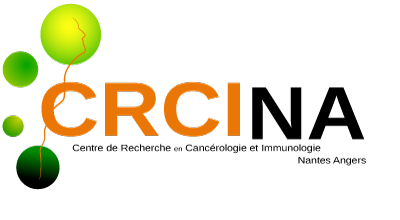Development, physico-chemical characterization and biological evaluation of silk fibroin/hyaluronic acid freeze-dried sponges for the trapping of Glioblastoma cells
Développement, caractérisation physico-chimique et évaluation biologique d'éponges lyophilisées de fibroïne de soie et acide hyaluronique pour le piégeage de cellules de glioblastome
Résumé
Glioblastoma (GBM) is a devastating tumour of the central nervous system. Despite an aggressive treatment, recurrence is inevitable, and the application of an effective therapeutic strategy remains a challenge. The breakthrough concept of cancer cell trap may offer new hopes and opportunities. The goal is to attract and confine the residual cancer cells surrounding the surgical cavity in a biomimetic polymeric scaffold delivering chemoattractive molecules. The stromal cell-derived factor-1α (SDF-1α), also called CXCL12, binds selectively to the CXCR4 receptor on the surface of infiltrative GBM cells and may be useful for inducing chemotaxis and the recruitment of residual GBM cells. In this work, series of freeze-dried sponges were prepared by combining silk fibroin (SF), hyaluronicacid (HA), poly-L-lysine (PLL) and heparin crosslinked with N-(3-dimethylaminopropyl)-N′-ethylcarbodiimidehydrochloride (EDC) and N-hydroxysulfosuccinimidesodium salt (NHS). Sponges showed high porosity (near 90%) with mean pore diameters ca. 60 μm and contained up to 95% water once hydrated. They presented a soft texture close to the one of a brain with a Young’s Modulus down to 6 kPa. Moreover, addition of SF in the formulation yielded sponges with greater stability in PBS than the HA-PLL sponges. SF-HA and SF-HA-hep sponges were able to retain 75% and 93% of the SDF-1 protein respectively after 7 days in PBS supplemented with enzymes (hyaluronidase and heparinase). In vivo studies showed that the SF-HA and SF-HA-hep sponges were well tolerated in rats’ brain and that the SF-HA-hep sponge did not release SDF-1α after 7 days in the brain.
Le glioblastome (GBM) est une tumeur dévastatrice du système nerveux central. Malgré un traitement agressif, les récidives sont inévitables et l'application d'une stratégie thérapeutique efficace demeure un défi. Le concept révolutionnaire de piège à cellules cancéreuses peut offrir de nouvelles opportunités. L'objectif est d'attirer et de confiner les cellules cancéreuses résiduelles entourant la cavité chirurgicale dans un implant polymère biomimétique délivrant des molécules chimio attractantes. Le SDF-1α, également appelé CXCL12, se lie sélectivement au récepteur CXCR4 à la surface des cellules de GBM infiltrantes et peut être utile pour induire le recrutement de ces cellules. Des éponges lyophilisées ont été préparées en combinant de la fibroïne de soie (SF), de l'acide hyaluronique (HA), de la poly-L-lysine (PLL) et de l'héparine (hep) réticulée avec N-(3-diméthylaminopropyl)-N'-éthylcarbodiimide (EDC) et du N-hydroxysulfosuccinimide (NHS). Les éponges ont montré une porosité élevée (près de90%) avec des diamètres de pores moyens de 60 μm et contenait jusqu'à 95% d'eau une fois hydraté et un module de Young inférieur à 6 kPa. De plus, l'addition de SF dans la formulation a permis d’augmenter la stabilité des éponges dans le PBS comparé à l’éponge HA-PLL. Les éponges SF-HA et SF-HA-hep étaient capables de conserver 75% et93% de la protéine SDF-1α respectivement après 7 jours dans du PBS supplémenté en enzymes (hyaluronidase et héparinase). Des études in vivo ont montré que les éponges SF-HA et SF-HA-hep étaient bien tolérées dans le cerveau des rats et que l’éponge SF-HA-hep ne libérait pas de SDF-1α dans le cerveau après 7 jours.
| Origine | Version validée par le jury (STAR) |
|---|
